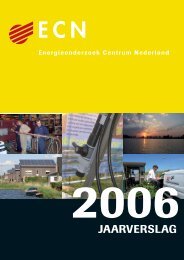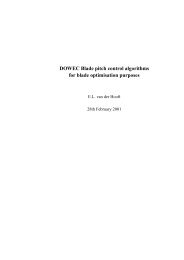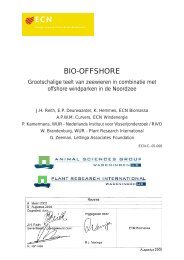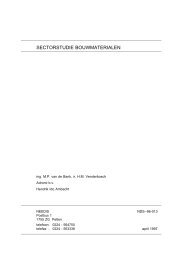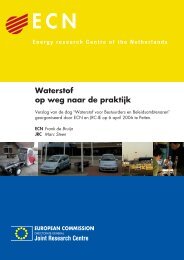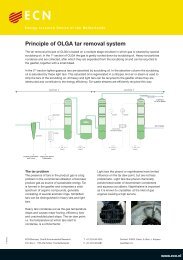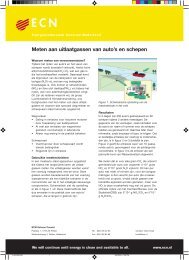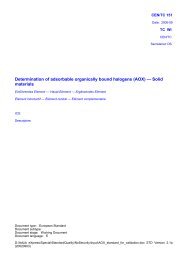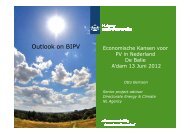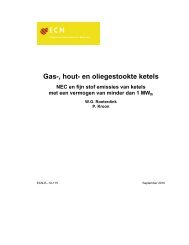PDF format (503 kB) - ECN
PDF format (503 kB) - ECN
PDF format (503 kB) - ECN
Create successful ePaper yourself
Turn your PDF publications into a flip-book with our unique Google optimized e-Paper software.
2.8 Pallets<br />
The last packaging category concerns pallets. In many industrial and trade sectors pallets are used intensively<br />
for internal and external transport of products. In Europe the production of pallets amounts to 280 million pallets<br />
per year [van Belkom, 1994]. About 96% of these pallets are made out of wood. Not too long ago, almost<br />
all pallets were used for one single trip and discarded afterwards. Due to environmental legislation an obvious<br />
trend is visible towards the use of multiple-use pallets. In Germany for example, the Verpackungs-Verordnung<br />
states that the taking back of pallets by industries is compulsory. The trend towards multiple use pallets has led<br />
to a large increase of the number of pallets that are part of pallet pools. In 1994 about one third of the pallets<br />
was returnable [van Belkom, 1994].<br />
We have modeled pallets by defining several pallets made from different materials like wood, PE, recycled PE,<br />
recycled PC, corrugated fiberboard and pressed wood fiber.<br />
The wooden pallets can be either single or multiple trip pallets. A single trip pallets weighs about 17 kg and a<br />
multiple use pallets weighs 25 kg. The main wood type used in production is softwood. Advantages of the<br />
wooden pallet is that it is cheap (USD 5 - USD 20) and made from renewable resources. The multiple trip pallets<br />
has an estimated trip number of 40 trips.<br />
Plastic pallets are used a lot in the food industry because they are easy to clean due to the smooth surface. Furthermore,<br />
no liquid can be absorbed by the pallets [Johnson, 1997]. The most common material for plastic pallet<br />
production in PE but in some cases also PC is used. Pallets made out of PC are stronger than PE pallets. Just<br />
like wooden pallets, plastic pallets can be used for single and multiple trips. A one-way plastic pallet weighs<br />
about 14 kg and a multiple use pallet weighs around 30 kilograms [TNO, 1994, van den Berg, 1996]. The costs<br />
of plastic pallets are higher than for wooden pallets. A PE pallet for multiple use costs around USD 75 and a<br />
pallet for single use costs about USD 12. If the pallets are made from recycled PE, they are much cheaper. The<br />
price for a multiple use recycled PE pallet starts at USD 25. Pallets that are made out of recycled PC are more<br />
expensive (USD 75) [van den Berg, 1996].For the multiple use plastic pallets we will use a trip number of 75<br />
trips.<br />
Pallets made from corrugated fiberboard are an option to replace single trip wooden pallets. The pallet costs<br />
about USD 6 which is cheap compared to wooden and plastic pallets [anon. 1993a]. The pallet weighs about 6<br />
kg which makes it a very light-weight pallet. This already has been a reason for some companies to use this<br />
pallet because it reduces the weight in the trailer [Witt, 1990].<br />
Pallets can also be made from pressed wood fibers. The advantage of these pallets is that they can save a lot of<br />
space if they are used for multiple-trip purposes because they use a fourth of the space of piled wooden pallets<br />
when stacked empty. Pressed wood fiber pallets are made out low grade fibers, mostly from bark and thinnings.<br />
The fibers are molded into a pressed wood pallet with the use of synthetic organic resins. The average costs of<br />
these pallets are about USD 5 and the average weight of the pallet amounts to 16 kg [anon., 1993a]. We will<br />
use a trip number of 5 trips per pallet.<br />
3 Costs and energy consumption calculations<br />
The introduction of new packaging (technology) is associated with a change in costs, both to the producer of<br />
the packaging as well as to the user (packager, transport, consumer). The viability of a material efficient packaging<br />
system will depend on the level of the costs. It is therefore, necessary to assess the costs of the various<br />
packaging systems. Furthermore changes in material use will have direct effects on energy use during production<br />
and transport of the packaging which can either strengthen or diminish the effects of different packaging<br />
system. To estimate these effects also the energy consumption of packaging making and transport should be<br />
calculated.



